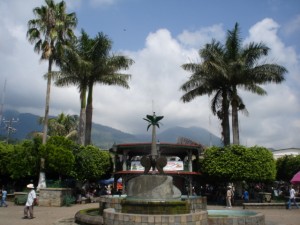 Xilitla is a little coffee producer town nestled in the Sierra Madre Oriental in the higher parts of the Huasteca Potosino, due to its location coffee beans are harvested as well as many kind of citrus. This place is surrounded by the most impressive waterfalls, high mountains and extensive vegetation which make this area a true paradise to admire the great variety of flora and fauna in the region. The name “Xilitla” has Nahuatl roots, it has been said that it means “Snail place”. Upon arrival of the Augustinian missionaries in the sixteenth century, was renamed as “St. Augustine of the great Xilitla”, so from then on is known only as Xilitla.
Xilitla is a little coffee producer town nestled in the Sierra Madre Oriental in the higher parts of the Huasteca Potosino, due to its location coffee beans are harvested as well as many kind of citrus. This place is surrounded by the most impressive waterfalls, high mountains and extensive vegetation which make this area a true paradise to admire the great variety of flora and fauna in the region. The name “Xilitla” has Nahuatl roots, it has been said that it means “Snail place”. Upon arrival of the Augustinian missionaries in the sixteenth century, was renamed as “St. Augustine of the great Xilitla”, so from then on is known only as Xilitla.
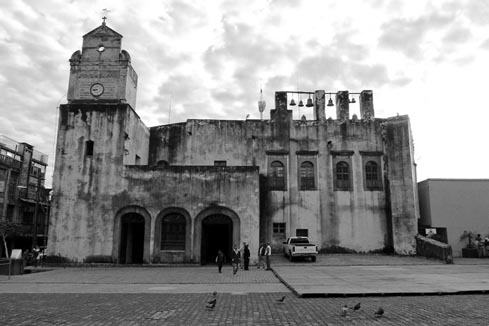 In 1553 began the construction of the Convent of Xilitla, which should serve as a fortress to resist the attacks of Chichimecas tribe. But the convent was attacked product of resentment from the Indigenous against the Spanish authorities, the sacristy was robbed and the vault burned, with all these problems the Augustinian friars withdrew Xilitla late sixteenth century.
In 1553 began the construction of the Convent of Xilitla, which should serve as a fortress to resist the attacks of Chichimecas tribe. But the convent was attacked product of resentment from the Indigenous against the Spanish authorities, the sacristy was robbed and the vault burned, with all these problems the Augustinian friars withdrew Xilitla late sixteenth century.
During the time of the Revolution, Xilitla was beset by the revolutionary troops and government forces, so it was practically abandoned. The now ex-convent of San Agustin is considered as the oldest building in San Luis Potosi and has already been restored.
 One of the main attractions of Xilitla is the surreal castle named “Las Pozas”. Las Pozas is a surreal architectural and sculptural art set created by Edward James an eccentric English poet and artist, in the municipality of Xilitla in a land of 40 acres where he built 36 structures. The origin of Las Pozas dates back to 1947 when Edward James, who lived in a kind of semi-exile in Mexico, bought a coffee plantation in Xilitla, and registered under the name of his great friend Plutarco Gastelum, who later became the overseer of all construction. Over the next ten years, Edward James used his land for planting orchids and as home to different species of exotic animals. But in 1962, after an unprecedented freeze that destroyed much of planting orchid, Edward James began construction of the extraordinary sculpture garden that we know today, hiring local workers and Gastelum as foreman. James lived in a Gothic style house with Plutarco and his family; later on this house became a Hotel. The design of Las Pozas was inspired by both his orchids and the vegetation of the Huasteca Potosino, combining architectural elements borrowed from the surrealist movement in which Edward James was immersed.
One of the main attractions of Xilitla is the surreal castle named “Las Pozas”. Las Pozas is a surreal architectural and sculptural art set created by Edward James an eccentric English poet and artist, in the municipality of Xilitla in a land of 40 acres where he built 36 structures. The origin of Las Pozas dates back to 1947 when Edward James, who lived in a kind of semi-exile in Mexico, bought a coffee plantation in Xilitla, and registered under the name of his great friend Plutarco Gastelum, who later became the overseer of all construction. Over the next ten years, Edward James used his land for planting orchids and as home to different species of exotic animals. But in 1962, after an unprecedented freeze that destroyed much of planting orchid, Edward James began construction of the extraordinary sculpture garden that we know today, hiring local workers and Gastelum as foreman. James lived in a Gothic style house with Plutarco and his family; later on this house became a Hotel. The design of Las Pozas was inspired by both his orchids and the vegetation of the Huasteca Potosino, combining architectural elements borrowed from the surrealist movement in which Edward James was immersed.
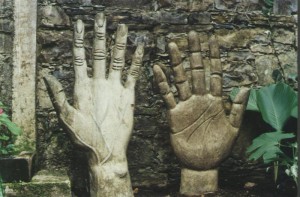 On the death of James, the Gastelum family inherited the whole property. The Edward James Foundation and the West Dean College withdrew the support they gave for a long time to the construction of Las Pozas, so the structures of the set remained without maintenance, causing deterioration of many. Among the principal buildings are the stairway to heaven, three-story structure, the bedroom with whale-shaped roof, the House of the colonnades and the structure called “El Cine” (The Cinema) where James used to play films to the workers and their families.
On the death of James, the Gastelum family inherited the whole property. The Edward James Foundation and the West Dean College withdrew the support they gave for a long time to the construction of Las Pozas, so the structures of the set remained without maintenance, causing deterioration of many. Among the principal buildings are the stairway to heaven, three-story structure, the bedroom with whale-shaped roof, the House of the colonnades and the structure called “El Cine” (The Cinema) where James used to play films to the workers and their families.
Other sites of interest around are:
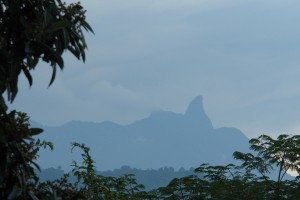 La Silleta, is undoubtedly the highest point of Xilitla geography, to reach this place people must travel through different colorful communities and varied vegetation where coffee and corn are grown; the last stretch of climb is almost vertical so that it is only recommended for climbing experts with the proper equipment, it represents a challenge for fans who want direct contact with nature.
La Silleta, is undoubtedly the highest point of Xilitla geography, to reach this place people must travel through different colorful communities and varied vegetation where coffee and corn are grown; the last stretch of climb is almost vertical so that it is only recommended for climbing experts with the proper equipment, it represents a challenge for fans who want direct contact with nature.
La Cueva de los Pericos (Parakeet Cave) is a large cave, home of a large family of green parrots (between 10 and 12 inches long) it takes about 15 minutes walking from Xilitla to get there, and it is recommended to arrive to the cave about an hour before sunset to witness the arrival of noisy parakeets.
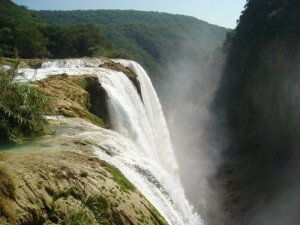 The Tamul Waterfall is the largest and most impressive waterfall in the state. The Gallinas River meets the Rio Santa Maria to form a cascade of a drop of 100 meters with up to 300 meters wide in the rainy season. To visit these falls it is possible to rent a boat with a guide in the town of Tanchanchín. The guide will take you on an incredible journey upstream, ending in a strong current. It takes about 2 hours upriver, which includes several stops for swimming, visiting water caves and other waterfalls; the way back takes about 45 minutes. The best is to make this trip from October to May to avoid the rain season.
The Tamul Waterfall is the largest and most impressive waterfall in the state. The Gallinas River meets the Rio Santa Maria to form a cascade of a drop of 100 meters with up to 300 meters wide in the rainy season. To visit these falls it is possible to rent a boat with a guide in the town of Tanchanchín. The guide will take you on an incredible journey upstream, ending in a strong current. It takes about 2 hours upriver, which includes several stops for swimming, visiting water caves and other waterfalls; the way back takes about 45 minutes. The best is to make this trip from October to May to avoid the rain season.
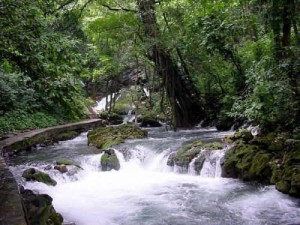 Tambaque is a nice place to swim in the Tanute River. There are natural pools with shallow and clean water. It may reach Tambaque in about an hour from Xilitla. This is a wonderful place where the water leaves the soil through an opening at the peak and falls through cascades over mossy rocks.
Tambaque is a nice place to swim in the Tanute River. There are natural pools with shallow and clean water. It may reach Tambaque in about an hour from Xilitla. This is a wonderful place where the water leaves the soil through an opening at the peak and falls through cascades over mossy rocks.
Tancanhuitz de Santos or Santos city is a place dedicated to Pedro Antonio Santos, a revolutionary martyr born near there. The name of this town means place where the flower of love blossoms. Here you can see the local indigenous Huasteca dressed in typical style. In the center, near the square, you can visit the local prison, where you can buy handicrafts made by prisoners. Also near the square is possible to climb to a beautiful church that was built on top of an ancient pyramid Huasteca. Santos is about 40 minutes from Xilitla
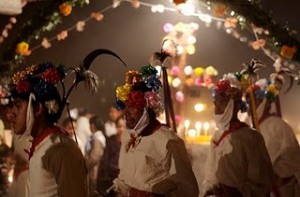 The local festival is the coffee fair, which is held every year in August, with activities like Huasteca dances, Huapango music, cultural events and fireworks. The Day of the Dead celebrations is the major celebration throughout the Huasteca region. In all the area are placed beautiful altars adorned with flowers, fruits, tamales, breads and diverse types of casseroles, the graves are decorated to honor the souls of the dead’s. Visitors are encouraged to eat at every house and participate in the festivities which begin on October 31 and continue until 2 November.
The local festival is the coffee fair, which is held every year in August, with activities like Huasteca dances, Huapango music, cultural events and fireworks. The Day of the Dead celebrations is the major celebration throughout the Huasteca region. In all the area are placed beautiful altars adorned with flowers, fruits, tamales, breads and diverse types of casseroles, the graves are decorated to honor the souls of the dead’s. Visitors are encouraged to eat at every house and participate in the festivities which begin on October 31 and continue until 2 November.
